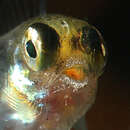Diagnostic Description
provided by Fishbase
Segmented dorsal fin rays 16 (rarely 15 or 17); segmented anal fin rays 18 (rarely 16-17); supraorbital tentacle comprised of a long, stout main tentacle bearing 3 to 9 (rarely 9) side branches; head lateral line system with 120 to 266 pores (mean 207.4); male Western Australian species with intense spotting on lower side of head; with round light brown blotch on postorbital region bordered by a typically segmented white, dark-edged streak; numerous medium to blackish brown blotches on lower half of cheek, sides of upper lip, suborbital area, branchiostegal membranes, pectoral fin base and basal 1/3 of pectoral fin; 6 to 7 groups of elongate rows of dark blotches on upper 2/3 of body.
Life Cycle
provided by Fishbase
Oviparous, distinct pairing (Ref. 205).
Morphology
provided by Fishbase
Dorsal spines (total): 12; Dorsal soft rays (total): 15 - 17; Anal spines: 2; Analsoft rays: 16 - 18
Biology
provided by Fishbase
Oviparous. Eggs are demersal and adhesive (Ref. 205), and are attached to the substrate via a filamentous, adhesive pad or pedestal (Ref. 94114). Larvae are planktonic, often found in shallow, coastal waters (Ref. 94114).
- Recorder
- Estelita Emily Capuli

